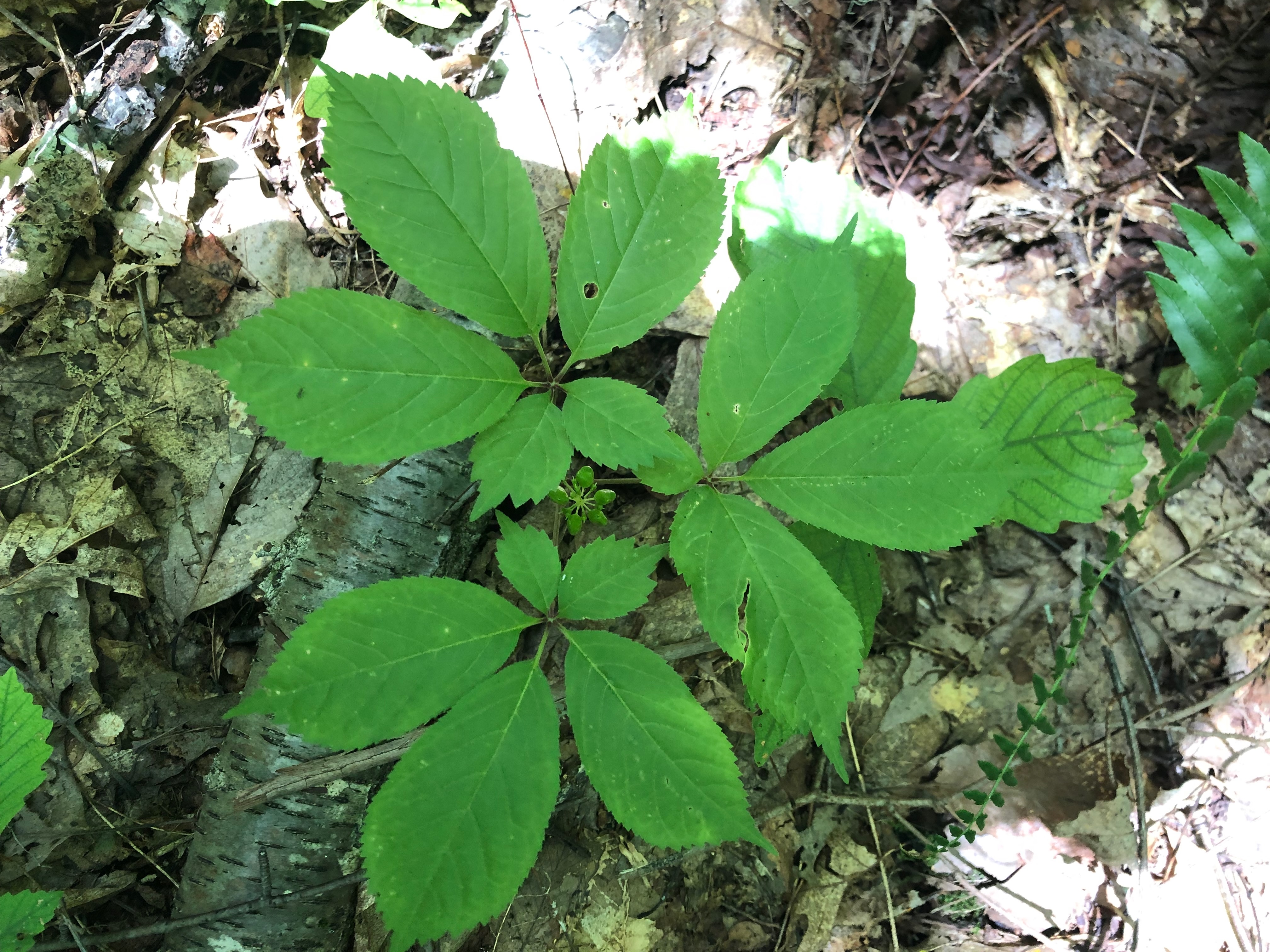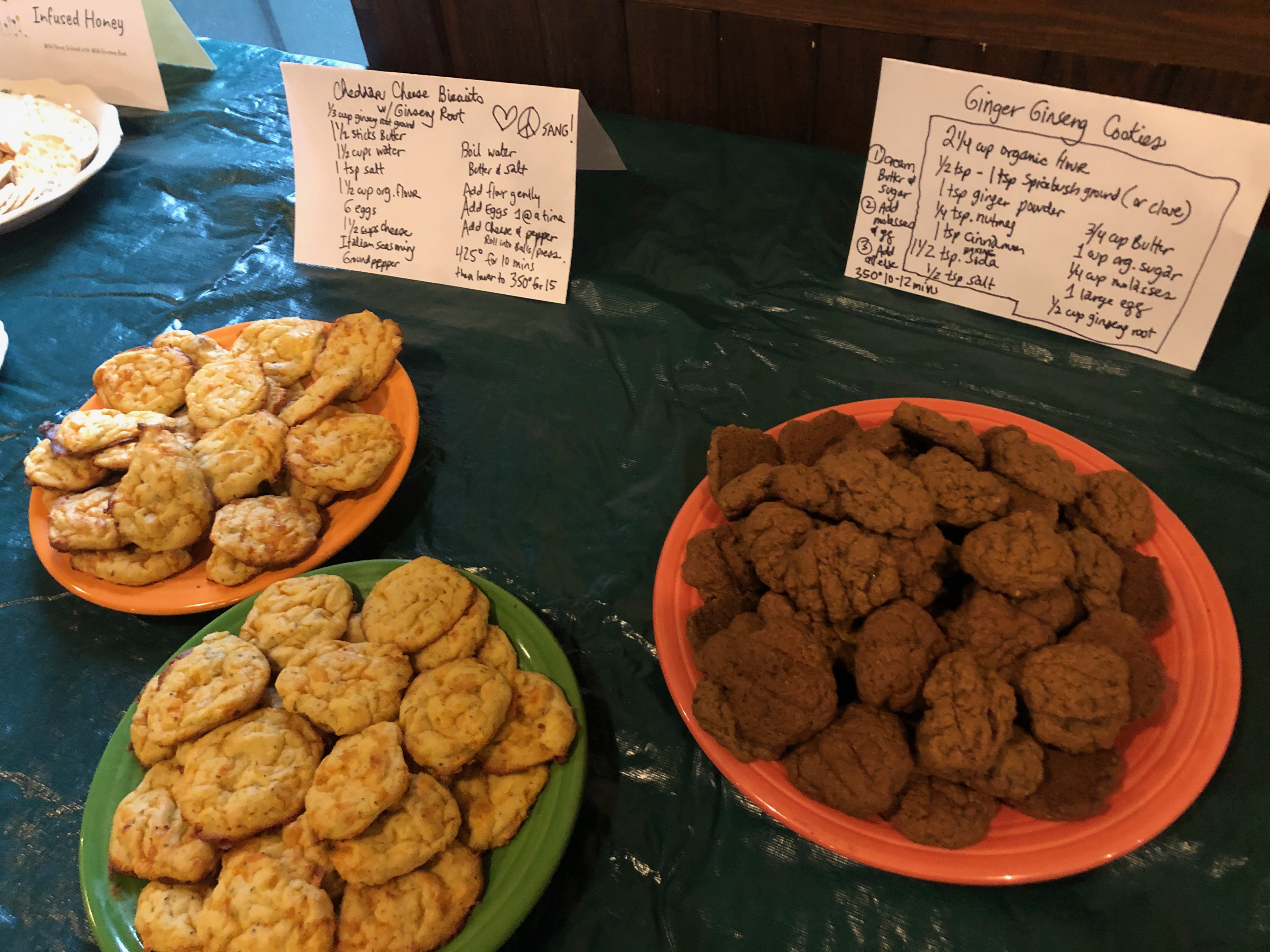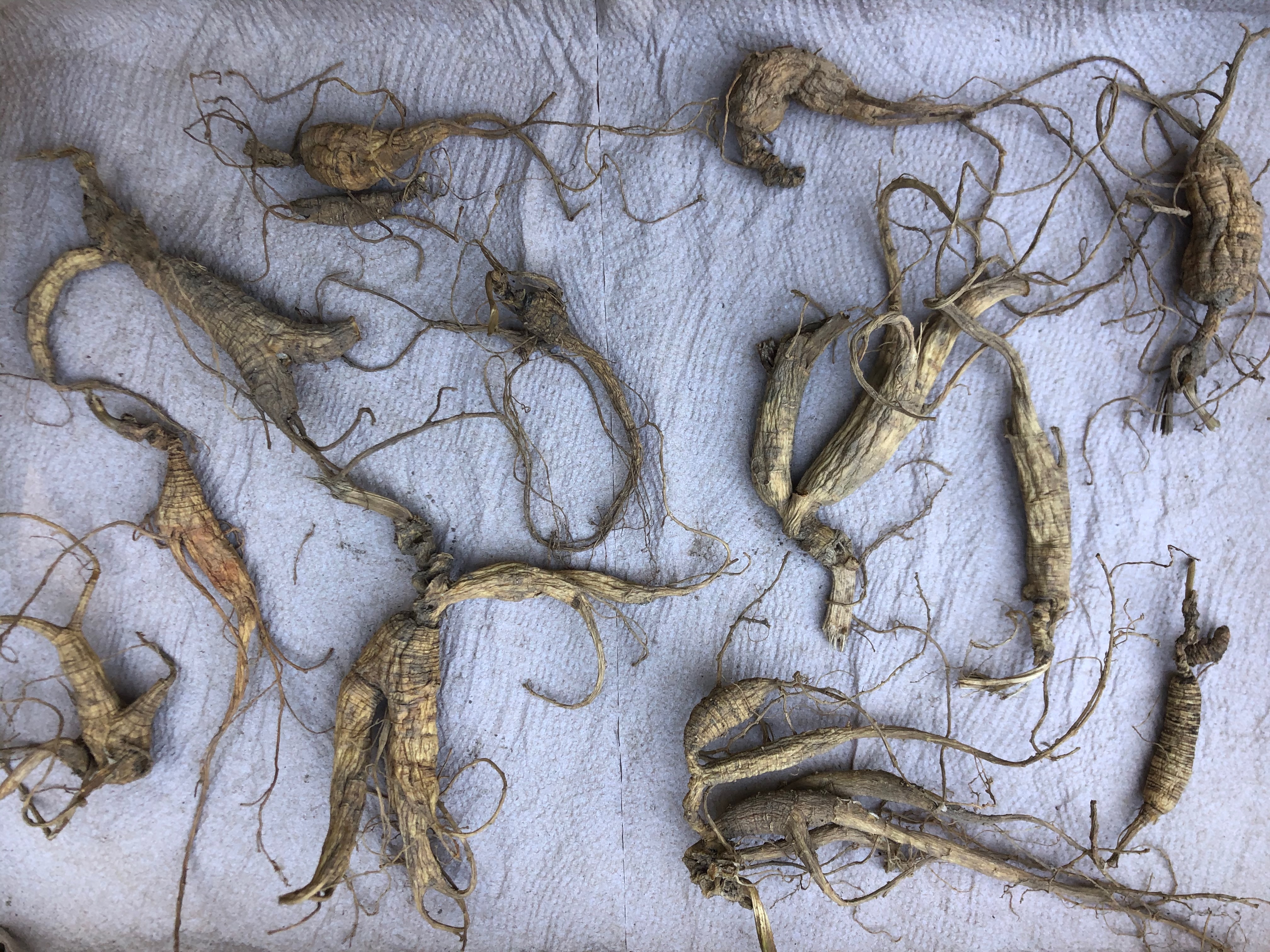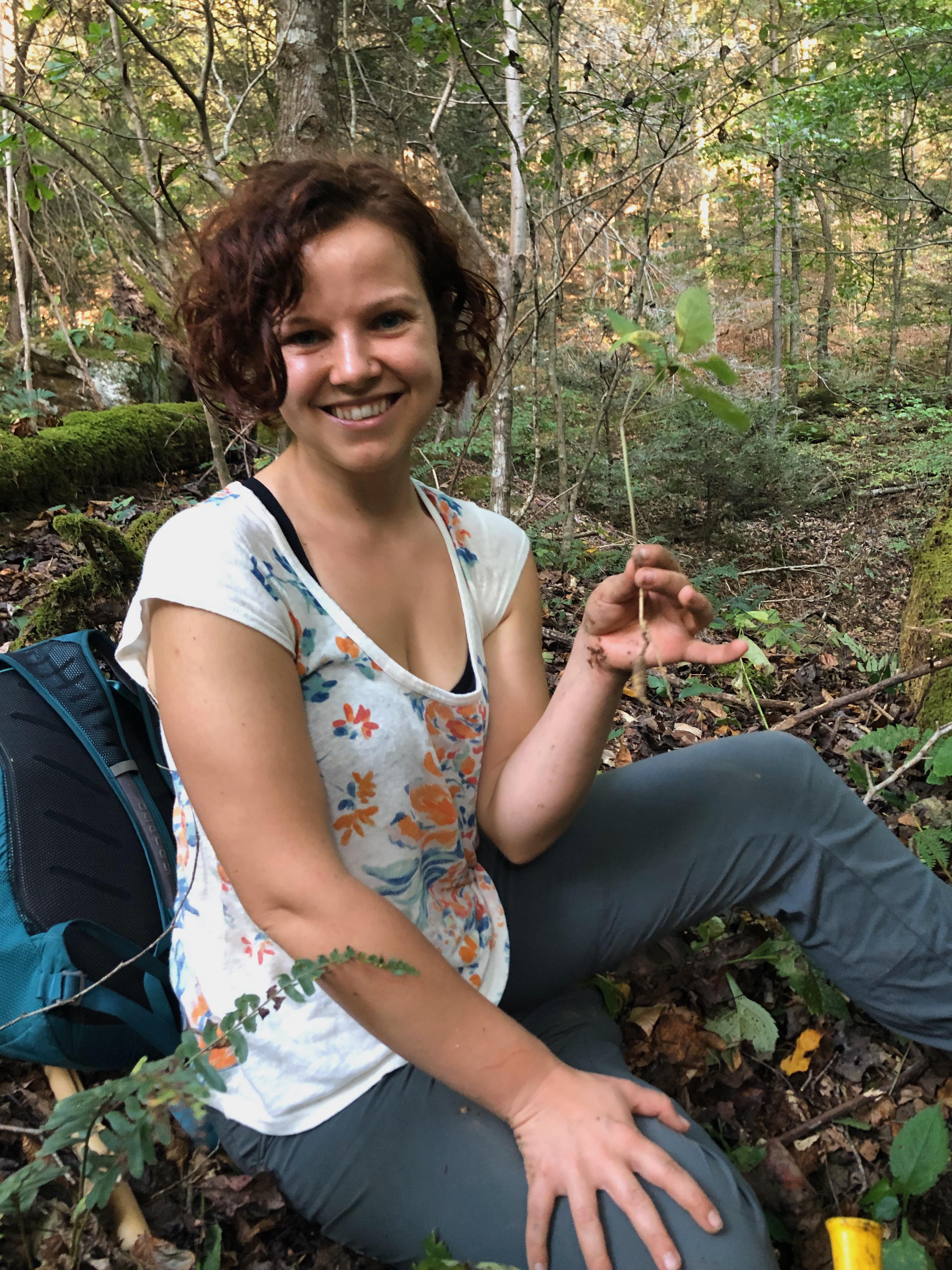American ginseng / Panax quinquefolius / Kate Farley
American ginseng
Panax quinquefolius
Kate Farley
An Appalachian Treasure Hunt
Early in my first visit to West Virginia during the summer of 2017, I spent an evening sipping wine from a Mason jar around a bonfire with some artists and folklorists dedicated to promoting and preserving Appalachian culture. It was my first summer as a PhD student in cultural anthropology, and I wanted to know how people were surviving in a place that had been ecologically and economically scarred by decades of timber harvesting and coal mining. One thing that some people do, I learned, was scour the woods in search of wild American ginseng (Panax quinquefolius) to harvest and sell. These “ginseng hunters” are secretive, but skilled hunters can make thousands of dollars from these wild roots. I had to learn more. Over the next few years I came to know ginseng harvesters who shared their love for this plant with me.

A ginseng plant growing on the forest floor displaying three “prongs,” or leaves with five leaflets each, and unripe green berries.
American ginseng is very closely related to Asian ginseng (Panax ginseng), which grows in northeastern China and the Korean peninsula. Both ginsengs are used in Traditional Chinese Medicine (TCM) and other Asian folk medicine systems. In TCM, ginseng strengthens qi (氣), the vital life force or energy that flows through all things, and directs it toward parts of the body that need healing or strengthening. Ginseng, then, is often used to ward off the infirmities of old age, to assist in healing from illness or injury, and to provide a stimulating boost of energy. These uses are reflected in the plant’s Latin genus name—Panax shares etymology with the word panacea, or cure-all.
Ginseng also has a history of medicinal use in Appalachia, first by Indigenous people and later by settlers of European descent. Some ginseng harvesters will still consume ginseng, usually broken roots or parts of the plant that can’t be profitably sold. As one harvester explained, “the leaves are medicine and the roots are money.” In Appalachia, ginseng is consumed by chewing on bits of the raw root, by preparing a tea from the roots or the leaves, or by soaking the root in moonshine or other clear alcohol. It is particularly valued as a stimulant and as a tonic that promotes longevity. I have personally experienced at least some of these benefits. At a ginseng auction, I once ate several delicious cookies made with ginseng leaves, which made me feel like I was full of enough extra energy to run a marathon. Months later I made a tincture with ginseng roots that were gifted to me, which I used for a little extra boost of mental energy as I was writing my doctoral dissertation.

A side table at a ginseng event with a tray of ginger ginseng cookies and a tray of cheddar ginseng biscuits.
Though it is possible to farm ginseng, wild ginseng is thought to possess much more concentrated and potent medicinal properties. Wild roots sell for orders of magnitude more money than cultivated roots. Roots produced on a farm tend to be large and pale, looking a little like parsnips with extra appendages, and might sell for $20 or $30 per pound. The smaller, darker, wrinkled roots a wild ginseng harvester can find might sell for over $1000 in a good year—and unusually large or well-shaped roots can sell for substantially more than that. Good jobs that pay a living wage in Appalachia are hard to come by, so ginseng can be an important source of supplemental income. I met people who use it to buy Christmas presents for their children, to buy heating oil for the winter, and even to pay for community college classes to train in new skills after getting laid off from a coal mining job.

Several mostly-dry ginseng roots are arranged on top of paper towels in a cardboard tray.
Harvesters tell stories about how ginseng was once the “dominant plant in the understory,” but these days it isn’t easy to find. Ginseng is often found in places that are hard to get to—at the tops of cliffs, under thorny bushes, deep in the woods far from roads. A successful day of ginseng harvesting can require hiking for hours through the trailless woods, often across very steep and treacherous terrain. Harvesters compare the search for ginseng to a treasure hunt or an Easter egg hunt. Many tell me stories about the challenges they have faced in harvesting “mountain monsters,” or particularly large or old ginseng roots, that bring to mind the way that deer hunters and fishermen will talk about the time they got (or almost got) “the big one.”
Finding ginseng might be a treasure hunt, but this also reflects the fact that wild ginseng populations are in decline. Environmentalists and forest managers will often blame poor Appalachians for this decline, citing unsustainable harvesting methods. Though some individual harvesters do dig plants unsustainably, there is also an active culture of stewardship among ginseng harvesters. They plant seeds, maintain private ginseng patches in areas where they can be guarded from poachers, they leave large plants to produce seeds, and they teach others to do the same. Other factors, ranging from fossil fuel extraction to timber harvests to white-tailed deer overpopulation to climate change, may be having just as much or more of an impact on ginseng populations. In the face of these broader environmental and economic forces, Appalachian ginseng harvesters can be a partner for ginseng conservation through stewardship activities, not the enemy.
Further Reading
Case, Martha A., Kathryn M. Flinn, Jean Jancaitis, Ashley Alley, and Amy Paxton. 2007. “Declining Abundance of American Ginseng (Panax Quinquefolius L.) Documented by Herbarium Specimens.” Biological Conservation 134 (1): 22–30.
Farley, Katherine. 2022. “‘We Ain’t Never Stolen a Plant’: Livelihoods, Property, and Illegal Ginseng Harvesting in the Appalachian Forest Commons.” Economic Anthropology 9 (2): 309–21.
Hufford, Mary. 2003. “Knowing Ginseng: The Social Life of an Appalachian Root.” Cahiers de Littérature Orale 53–54: 265–92.
Law, Justine. 2022. “The Knotty Politics of Ginseng Conservation and Management in Appalachia.” Journal of Political Ecology 29: 36–50.
Manget, Luke. 2022. Ginseng Diggers: A History of Root and Herb Gathering in Appalachia. Lexington, Kentucky: University Press of Kentucky.
McGraw, James, Anne E. Lubbers, Martha Van der Voort, Emily H. Mooney, Mary Ann Furedi, Sara Souther, Jessica B. Turner, and Jennifer Chandler. 2013. “Ecology and Conservation of Ginseng (Panax Quinquefolius) in a Changing World.” Annals of the New York Academy of Sciences 1286 (1): 62–91.
About the author

Kate Farley is an assistant scientist at the William L. Brown Center at the Missouri Botanical Garden in St. Louis, MO. She has a Ph.D. in cultural anthropology from Washington University in St. Louis and a master's in environmental management from Yale School of the Environment. She is interested in social dimensions of conservation, especially instances when biodiversity conservation seems to conflict with local livelihoods. Her research has primarily focused on Appalachia and the Ozarks in North America and she soon plans to begin a new project addressing similar themes in Madagascar.
The Society for Ethnobotany is open to researchers, practitioners, and enthusiasts of ethnobotany and economic botany.
The 2026 SEB Annual Meeting will take place in Montpellier, France, from May 31-June 4th!
If you have an interest in ethnobotany or economic botany you can become a member of the Society for Ethnobotany.
If you are a member of the Society for Ethnobotany and would like to contribute a Favorite Plant please contact Blair Orr, blairorr@ymail.com. (Note: ymail, not gmail.)
